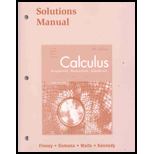
(a)
To find: The domain of the function
(a)
Answer to Problem 53RE
The domain of the given function is
Explanation of Solution
Given information:The given function is
Calculation:
Consider the function.
The domain is the set of input values for which the function is defined. The function is not defined for:
So, the domain of the function is the set of all real numbers except 3 and
Therefore, thedomain of the given function is
(b)
To find:The equation of each vertical asymptote for the graph of
(b)
Answer to Problem 53RE
The vertical asymptote of a function are
Explanation of Solution
Given information:The given function is
Calculation:
The value of x for which the denominator of a function is equal to zero is known as the vertical asymptote of the function.
The denominator of the function
Therefore, the vertical asymptote of a function are
(c)
To find: The equation of each horizontal asymptote of the given function.
(c)
Answer to Problem 53RE
The horizontal asymptotefor the graph of given function is
Explanation of Solution
Given information:The given function is
Calculation:
The graph of a function has horizontal asymptote at
For the function
Therefore, the horizontal asymptote for the graph of given function is
(d)
To check:Whether the givenfunction isodd, even or neither.
(d)
Answer to Problem 53RE
The given function is an odd function.
Explanation of Solution
Given information:The given function is
Calculation:
Substitute
Therefore, the given function is an odd function
(e)
To find: The value of
(e)
Answer to Problem 53RE
The given function is discontinuous for
Explanation of Solution
Given information:The given function is
The function is not defined for
Therefore, the given function is discontinuous for
Chapter 2 Solutions
Calculus: Graphical, Numerical, Algebraic: Solutions Manual
Additional Math Textbook Solutions
College Algebra with Modeling & Visualization (5th Edition)
Elementary Statistics
Calculus for Business, Economics, Life Sciences, and Social Sciences (14th Edition)
Introductory Statistics
Intro Stats, Books a la Carte Edition (5th Edition)
Pre-Algebra Student Edition
- explain of logical relationships of (11.1.1), (11.1.2), (11.3.4), (11.3.6)arrow_forwardProve 11.1.2arrow_forward39. (a) Show that Σeak converges for each α > 0. (b) Show that keak converges for each a > 0. k=0 (c) Show that, more generally, Σk"eak converges for each k=0 nonnegative integer n and each a > 0.arrow_forward
- #3 Find the derivative y' = of the following functions, using the derivative rules: dx a) y-Cos 6x b) y=x-Sin4x c) y=x-Cos3x d) y=x-R CD-X:-:TCH :D:D:D - Sin f) Sin(x²) (9) Tan (x³)arrow_forwardmate hat is the largest area that can be en 18 For the function y=x³-3x² - 1, use derivatives to: (a) determine the intervals of increase and decrease. (b) determine the local (relative) maxima and minima. (c) determine the intervals of concavity. (d) determine the points of inflection. b) (e) sketch the graph with the above information indicated on the graph.arrow_forwarduse L'Hopital Rule to evaluate the following. a) 4x3 +10x2 23009׳-9 943-9 b) hm 3-84 хто бу+2 < xan x-30650)arrow_forward
 Calculus: Early TranscendentalsCalculusISBN:9781285741550Author:James StewartPublisher:Cengage Learning
Calculus: Early TranscendentalsCalculusISBN:9781285741550Author:James StewartPublisher:Cengage Learning Thomas' Calculus (14th Edition)CalculusISBN:9780134438986Author:Joel R. Hass, Christopher E. Heil, Maurice D. WeirPublisher:PEARSON
Thomas' Calculus (14th Edition)CalculusISBN:9780134438986Author:Joel R. Hass, Christopher E. Heil, Maurice D. WeirPublisher:PEARSON Calculus: Early Transcendentals (3rd Edition)CalculusISBN:9780134763644Author:William L. Briggs, Lyle Cochran, Bernard Gillett, Eric SchulzPublisher:PEARSON
Calculus: Early Transcendentals (3rd Edition)CalculusISBN:9780134763644Author:William L. Briggs, Lyle Cochran, Bernard Gillett, Eric SchulzPublisher:PEARSON Calculus: Early TranscendentalsCalculusISBN:9781319050740Author:Jon Rogawski, Colin Adams, Robert FranzosaPublisher:W. H. Freeman
Calculus: Early TranscendentalsCalculusISBN:9781319050740Author:Jon Rogawski, Colin Adams, Robert FranzosaPublisher:W. H. Freeman
 Calculus: Early Transcendental FunctionsCalculusISBN:9781337552516Author:Ron Larson, Bruce H. EdwardsPublisher:Cengage Learning
Calculus: Early Transcendental FunctionsCalculusISBN:9781337552516Author:Ron Larson, Bruce H. EdwardsPublisher:Cengage Learning





